Pheidole floridana
| Pheidole floridana | |
|---|---|

| |
| Scientific classification | |
| Kingdom: | Animalia |
| Phylum: | Arthropoda |
| Class: | Insecta |
| Order: | Hymenoptera |
| Family: | Formicidae |
| Subfamily: | Myrmicinae |
| Tribe: | Attini |
| Genus: | Pheidole |
| Species: | P. floridana |
| Binomial name | |
| Pheidole floridana Emery, 1895 | |
| Synonyms | |
| |
At Bald Point, Franklin Co., Florida, I found colonies nesting at a roadside in open sandy soil; and in Mobile, Alabama (in 1942) what was probably this species nesting beneath a whiskey bottle in a vacant lot. Winged reproductives have been found in nests during September and October. Stefan Cover (personal communication) reports that floridana “occurs in a variety of woodland habitats, nests in soil, litter, and rotten wood, and in both xeric and mesic situations. Colonies are monogynous, may contain 1000 or more ants, and are sometimes polydomous. The species is omnivorous, but does not appear to harvest seeds.” (Wilson 2003)
Identification
See the description in the nomenclature section.
Keys including this Species
Distribution
P. floridana has been recorded by Stefan Cover (personal communication) from the coastal plain of North Carolina south to the Florida Keys and west to central Texas (Austin and surrounding area), thence south into Mexico. (Wilson 2003)
Latitudinal Distribution Pattern
Latitudinal Range: 35.59° to 24.55792°.
| North Temperate |
North Subtropical |
Tropical | South Subtropical |
South Temperate |
- Source: AntMaps
Distribution based on Regional Taxon Lists
Nearctic Region: United States (type locality).
Neotropical Region: Mexico.
Distribution based on AntMaps
Distribution based on AntWeb specimens
Check data from AntWeb
Countries Occupied
| Number of countries occupied by this species based on AntWiki Regional Taxon Lists. In general, fewer countries occupied indicates a narrower range, while more countries indicates a more widespread species. |

|
Estimated Abundance
| Relative abundance based on number of AntMaps records per species (this species within the purple bar). Fewer records (to the left) indicates a less abundant/encountered species while more records (to the right) indicates more abundant/encountered species. |

|
Biology
Flight Period
| X | X | ||||||||||
| Jan | Feb | Mar | Apr | May | Jun | Jul | Aug | Sep | Oct | Nov | Dec |
Source: antkeeping.info.
- Check details at Worldwide Ant Nuptial Flights Data, AntNupTracker and AntKeeping.
 Explore: Show all Flight Month data or Search these data. See also a list of all data tables or learn how data is managed.
Explore: Show all Flight Month data or Search these data. See also a list of all data tables or learn how data is managed.
Life History Traits
- Queen number: monogynous (Frumhoff & Ward, 1992)
Castes
Images below provided by the Museum of Comparative Zoology and California Academy of Sciences
Worker
Minor
Images from AntWeb
   
| |
| Worker. Specimen code casent0104402. Photographer April Nobile, uploaded by California Academy of Sciences. | Owned by ABS, Lake Placid, FL, USA. |
Major
  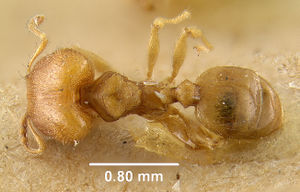 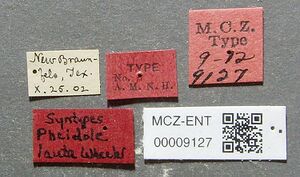 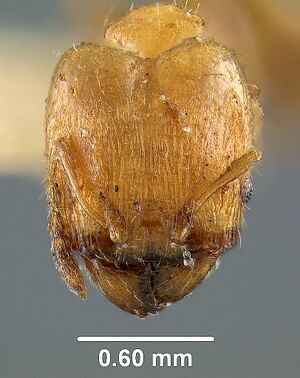  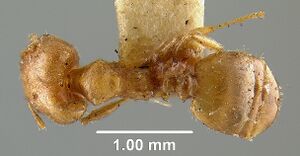     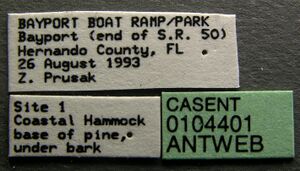
| |
| . | |
Queen
Images from AntWeb
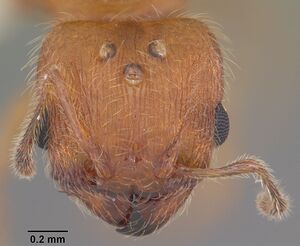   
| |
| Queen (alate/dealate). Specimen code casent0104403. Photographer April Nobile, uploaded by California Academy of Sciences. | Owned by ABS, Lake Placid, FL, USA. |
Male
Images from AntWeb
 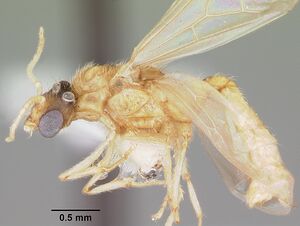   
| |
| Male (alate). Specimen code casent0104400. Photographer April Nobile, uploaded by California Academy of Sciences. | Owned by ABS, Lake Placid, FL, USA. |
Nomenclature
The following information is derived from Barry Bolton's Online Catalogue of the Ants of the World.
- floridana. Pheidole flavens subsp. floridana Emery, 1895c: 293 (s.w.q.) U.S.A. Raised to species: Pergande, 1896: 883; Emery, 1896g: 77. Senior synonym of lauta: Gregg, 1959: 21. See also: Wilson, 2003: 424.
- lauta. Pheidole lauta Wheeler, W.M. 1908e: 470 (s.w.q.m.) U.S.A. Subspecies of floridana: Creighton, 1950a: 179. Junior synonym of floridana: Gregg, 1959: 21.
Unless otherwise noted the text for the remainder of this section is reported from the publication that includes the original description.
Description
From Wilson (2003): Nearly identical with Pheidole bilimeki and its Neotropical variants, distinguished as follows.
Major: foveolation on dorsum of head very fine; first gastral tergite smooth and shiny; humerus less prominent in dorsal-oblique view.
Minor: antennal scapes relatively short, just reaching or barely surpassing the occipital corner; first gastral tergite smooth and shiny, with at most a light shagreening at the base of the tergite.
Both castes are consistently yellow. P. floridana is very close to Pheidole bilimeki, and also to Pheidole stomachosa of Jamaica, which coexists on the island with bilimeki. P. stomachosa is distinguished from both bilimeki and floridana by the minor’s head and pronotum being smooth and shiny (q.v.).
MEASUREMENTS (mm) Lectotype major: HW 0.92, HL 1.00, SL 0.44, EL 0.10, PW 0.46. Paralectotype minor: HW 0.44, HL 0.52, SL 0.42, EL 0.06, PW 0.30.
COLOR Major and minor: concolorous yellow.
Figure. Upper: lectotype, major (damaged specimen; pilosity added from a fresh specimen); the upper dorsal-oblique profile of mesosoma is the lectotype, and the lower profile is a major from Sarasota, Florida. Lower: paralectotype, minor (damaged specimen; pilosity added from a fresh specimen). Scale bars = 1 mm.
Type Material
Museum of Comparative Zoology and Museo Civico di Storia Naturale, Genoa - as reported in Wilson (2003)
Etymology
Named after the state of origin. (Wilson 2003)
References
- Wilson, E. O. 2003. Pheidole in the New World: A dominant, hyperdiverse ant genus. Harvard University Press, Cambridge, MA. (page 424, fig. major, minor described)
- Deyrup, M.A., Carlin, N., Trager, J., Umphrey, G. 1988. A review of the ants of the Florida Keys. Florida Entomologist 71: 163-176.
- Emery, C. 1895d. Beiträge zur Kenntniss der nordamerikanischen Ameisenfauna. (Schluss). Zool. Jahrb. Abt. Syst. Geogr. Biol. Tiere 8: 257-360 (page 293, soldier, worker, queen described)
- Emery, C. 1896g. Studi sulle formiche della fauna neotropica. XVII-XXV. Bull. Soc. Entomol. Ital. 28: 33-107 (page 77, raised to species)
- Gregg, R. E. 1959 [1958]. Key to the species of Pheidole (Hymenoptera: Formicidae) in the United States. J. N. Y. Entomol. Soc. 66: 7-48 (page 21, senior synonym of lauta)
- MacGown, J.A., Booher, D., Richter, H., Wetterer, J.K., Hill, J.G. 2021. An updated list of ants of Alabama (Hymenoptera: Formicidae) with new state records. Transactions of the American Entomological Society 147: 961-981 (doi:10.3157/061.147.0409).
- Moura, M.N., Cardoso, D.C., Cristiano, M.P. 2020. The tight genome size of ants: diversity and evolution under ancestral state reconstruction and base composition. Zoological Journal of the Linnean Society, zlaa135 (doi:10.1093/zoolinnean/zlaa135).
- Pergande, T. 1896. Mexican Formicidae. Proc. Calif. Acad. Sci. (2) 5: 858-896 (page 883, raised to species)
- Vázquez-Franco, C.M., Morrone, J.J. 2022. The genus Pheidole (Hymenoptera: Formicidae: Myrmicinae) in Puebla, Mexico. Revista Mexicana de Biodiversidad 93: e933820 (doi:10.22201/ib.20078706e.2022.93.3820).
References based on Global Ant Biodiversity Informatics
- Addison D. S., I. Bartoszek, V. Booher, M. A. Deyrup, M. Schuman, J. Schmid, and K. Worley. 2016. Baseline surveys for ants (Hymenoptera: Formicidae) of the western Everglades, Collier County, Florida. Florida Entomologist 99(3): 389-394.
- Annotated Ant Species List Ordway-Swisher Biological Station. Downloaded at http://ordway-swisher.ufl.edu/species/os-hymenoptera.htm on 5th Oct 2010.
- Atchison R. A., J. Hulcr, and A. Lucky. 2018. Managed fire frequency significantly influences the litter arthropod community in longleaf pine flatwoods. Environmental Entomology 20(10): 1-11.
- Clouse R. 1999. Leaf-Litter Inhabitants of a Brazilian Pepper Stand in Everglades National Park. The Florida Entomologist. 82: 388-403
- Dash S. T. and L. M. Hooper-Bui. 2008. Species diversity of ants (Hymenoptera: Formicidae) in Louisiana. Conservation Biology and Biodiversity. 101: 1056-1066
- Del Toro, I. 2010. PERSONAL COMMUNICATION. MUSEUM RECORDS COLLATED BY ISRAEL DEL TORO
- Deyrup M. 2016. Ants of Florida: identification and natural history. CRC Press, 423 pages.
- Deyrup M., C. Johnson, G. C. Wheeler, J. Wheeler. 1989. A preliminary list of the ants of Florida. Florida Entomologist 72: 91-101
- Deyrup M., L. Deyrup, and J. Carrel. 2013. Ant Species in the Diet of a Florida Population of Eastern Narrow-Mouthed Toads, Gastrophryne carolinensis. Southeastern Naturalist 12(2): 367-378.
- Deyrup, M. and J. Trager. 1986. Ants of the Archbold Biological Station, Highlands County, Florida (Hymenoptera: Formicidae). Florida Entomologist 69(1):206-228
- Epperson, D.M. and C.R. Allen. 2010. Red Imported Fire Ant Impacts on Upland Arthropods in Southern Mississippi. American Midland Naturalist, 163(1):54-63.
- Forster J.A. 2005. The Ants (hymenoptera: Formicidae) of Alabama. Master of Science, Auburn University. 242 pages.
- Jeanne R. J. 1979. A latitudinal gradient in rates of ant predation. Ecology 60(6): 1211-1224.
- Kempf, W.W. 1972. Catalago abreviado das formigas da regiao Neotropical (Hym. Formicidae) Studia Entomologica 15(1-4).
- Klotz, J.H., J.R. Mangold, K.M. Vail, L.R. Davis Jr., R.S. Patterson. 1995. A survey of the urban pest ants (Hymenoptera: Formicidae) of Peninsular Florida. Florida Entomologist 78(1):109-118
- LeBrun E. G., R. M. Plowes, and L. E. Gilbert. 2015. Imported fire ants near the edge of their range: disturbance and moisture determine prevalence and impact of an invasive social insect. Journal of Animal Ecology,81: 884–895.
- Lubertazzi D. and Tschinkel WR. 2003. Ant community change across a ground vegetation gradient in north Floridas longleaf pine flatwoods. 17pp. Journal of Insect Science. 3:21
- MacGown J. A., J. G. Hill, and M. Deyrup. 2009. Ants (Hymenoptera: Formicidae) of the Little Ohoopee River Dunes, Emanuel County, Georgia. J. Entomol. Sci. 44(3): 193-197.
- MacGown J. A., and R. Whitehouse. 2015. A preliminary report of the ants of West Ship Island. A report submitted to the Gulf Islands National Seashore. Mississippi Entomological Museum Report #2015-02. 9 pp.
- MacGown, J.A and J.A. Forster. 2005. A preliminary list of the ants (Hymenoptera: Formicidae) of Alabama, U.S.A. Entomological News 116(2):61-74
- McDonald D. L., D. R. Hoffpauir, and J. L. Cook. 2016. Survey yields seven new Texas county records and documents further spread of Red Imported Fire Ant, Solenopsis invicta Buren. Southwestern Entomologist, 41(4): 913-920.
- Moreau C. S., M. A. Deyrup, and L. R. David Jr. 2014. Ants of the Florida Keys: Species Accounts, Biogeography, and Conservation (Hymenoptera: Formicidae). J. Insect Sci. 14(295): DOI: 10.1093/jisesa/ieu157
- Morrison, L.W. 2002. Long-Term Impacts of an Arthropod-Community Invasion by the Imported Fire Ant, Solenopsis invicta. Ecology 83(8):2337-2345
- Moser J. C. and M. S. Blum. 1960. The Formicidae of Louisiana. Insect Conditions in Louisiana 3: 48-50
- O'Keefe S. T., J. L. Cook, T. Dudek, D. F. Wunneburger, M. D. Guzman, R. N. Coulson, and S. B. Vinson. 2000. The Distribution of Texas Ants. The Southwestern Entomologist 22: 1-92.
- Oyama L., J. R. King, and D. G. Jenkins. 2018. Diversity and distribution of Solenopsis (Hymenoptera: Formicidae) thief ants belowground. Myrmecological News 27: 47-57.
- Parys K. A., M. L. Gimmel, and S. J. Johnson. 2013. Checklist of Insects Associated with Salvinia minima Baker in Louisiana, USA. Check List 9(6): 14881495.
- Saarinen, E.V. and J.C. Daniels.2006. Miami blue butterfly larvae (Lepidoptera: Lycaenidae) and ants (Hymenoptera: Formicidae): New information on the symbionts of an endangered taxon. Florida Entomologist 89(1): 69-74
- Smith M. R. 1924. An annotated list of the ants of Mississippi (Hym.) (continued from page 54). Entomological News 35: 77-85.
- Wetterer, J.K. and J.A. Moore. 2005. Red Imported Fire Ants (Hymenoptera: Formicidae) at Gopher Tortoise (Testudines: Testudinidae) Burrows. The Florida Entomologist 88(4):349-354
- Wheeler, G.C. and J. Wheeler. 1985. A checklist of Texas ants. Prairie Naturalist 17:49-64.
- Whitcomb W. H., H. A. Denmark, A. P. Bhatkar, and G. L. Greene. 1972. Preliminary studies on the ants of Florida soybean fields. Florida Entomologist 55: 129-142.
- Wilson E. O. 1964. The ants of the Florida Keys. Breviora 210: 1-14.
- Wilson, E.O. 2003. Pheidole in the New World: A Dominant, Hyperdiverse Genus. Harvard University Press



